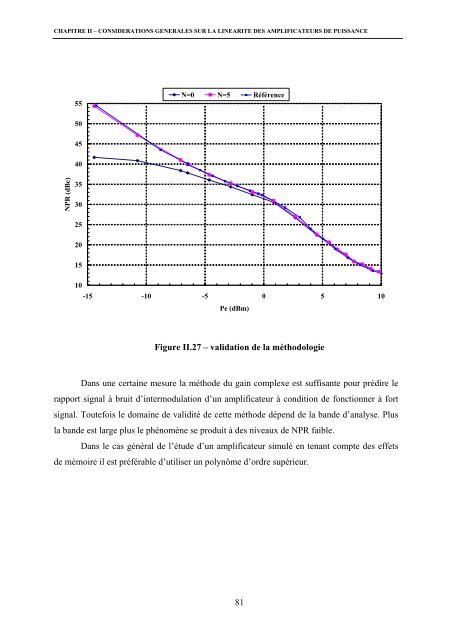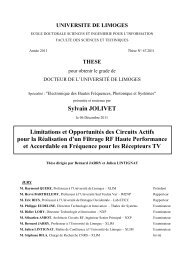- Page 1 and 2:
JURY : N° d'ordre : 9-2000 THÈSE
- Page 3 and 4:
Table des matières ******** CHAPIT
- Page 5 and 6:
III.3. - METHODOLOGIE ACTUELLE DE C
- Page 7 and 8:
Liste des figures ******** Figure I
- Page 9 and 10:
Figure III.9 - Contours à puissanc
- Page 11 and 12:
FigureIV.45 - Conditions de stabili
- Page 13 and 14:
INTRODUCTON GENERALE L’industrie
- Page 15 and 16:
CHAPITRE I - OUTILS DE MODELISATION
- Page 17 and 18:
CHAPITRE I - OUTILS DE MODELISATION
- Page 19 and 20:
CHAPITRE I - OUTILS DE MODELISATION
- Page 21 and 22:
CHAPITRE I - OUTILS DE MODELISATION
- Page 23 and 24:
CHAPITRE I - OUTILS DE MODELISATION
- Page 25 and 26:
CHAPITRE I - OUTILS DE MODELISATION
- Page 27 and 28:
CHAPITRE I - OUTILS DE MODELISATION
- Page 29 and 30:
CHAPITRE I - OUTILS DE MODELISATION
- Page 31 and 32:
CHAPITRE I - OUTILS DE MODELISATION
- Page 33 and 34:
CHAPITRE I - OUTILS DE MODELISATION
- Page 35 and 36:
CHAPITRE I - OUTILS DE MODELISATION
- Page 37 and 38:
CHAPITRE I - OUTILS DE MODELISATION
- Page 39 and 40:
CHAPITRE I - OUTILS DE MODELISATION
- Page 41 and 42: CHAPITRE I - OUTILS DE MODELISATION
- Page 43 and 44: CHAPITRE I - OUTILS DE MODELISATION
- Page 45 and 46: CHAPITRE I - OUTILS DE MODELISATION
- Page 47 and 48: CHAPITRE I - OUTILS DE MODELISATION
- Page 49 and 50: CHAPITRE I - OUTILS DE MODELISATION
- Page 51 and 52: CHAPITRE I - OUTILS DE MODELISATION
- Page 53 and 54: CHAPITRE I - OUTILS DE MODELISATION
- Page 55 and 56: CHAPITRE I - OUTILS DE MODELISATION
- Page 57 and 58: CHAPITRE II - CONSIDERATIONS GENERA
- Page 59 and 60: CHAPITRE II - CONSIDERATIONS GENERA
- Page 61 and 62: CHAPITRE II - CONSIDERATIONS GENERA
- Page 63 and 64: CHAPITRE II - CONSIDERATIONS GENERA
- Page 65 and 66: CHAPITRE II - CONSIDERATIONS GENERA
- Page 67 and 68: CHAPITRE II - CONSIDERATIONS GENERA
- Page 69 and 70: CHAPITRE II - CONSIDERATIONS GENERA
- Page 71 and 72: CHAPITRE II - CONSIDERATIONS GENERA
- Page 73 and 74: CHAPITRE II - CONSIDERATIONS GENERA
- Page 75 and 76: CHAPITRE II - CONSIDERATIONS GENERA
- Page 77 and 78: CHAPITRE II - CONSIDERATIONS GENERA
- Page 79 and 80: NPR (dB) CHAPITRE II - CONSIDERATIO
- Page 81 and 82: CHAPITRE II - CONSIDERATIONS GENERA
- Page 83 and 84: CHAPITRE II - CONSIDERATIONS GENERA
- Page 85 and 86: CHAPITRE II - CONSIDERATIONS GENERA
- Page 87 and 88: FACTEUR DE FORME (dB) CHAPITRE II -
- Page 89 and 90: CHAPITRE II - CONSIDERATIONS GENERA
- Page 91: CHAPITRE II - CONSIDERATIONS GENERA
- Page 95 and 96: CHAPITRE II - CONSIDERATIONS GENERA
- Page 97 and 98: CHAPITRE III - METHODOLOGIE DE CONC
- Page 99 and 100: CHAPITRE III - METHODOLOGIE DE CONC
- Page 101 and 102: CHAPITRE III - METHODOLOGIE DE CONC
- Page 103 and 104: CHAPITRE III - METHODOLOGIE DE CONC
- Page 105 and 106: CHAPITRE III - METHODOLOGIE DE CONC
- Page 107 and 108: CHAPITRE III - METHODOLOGIE DE CONC
- Page 109 and 110: CHAPITRE III - METHODOLOGIE DE CONC
- Page 111 and 112: NPR (dB) CHAPITRE III - METHODOLOGI
- Page 113 and 114: CHAPITRE III - METHODOLOGIE DE CONC
- Page 115 and 116: CHAPITRE III - METHODOLOGIE DE CONC
- Page 117 and 118: CHAPITRE III - METHODOLOGIE DE CONC
- Page 119 and 120: CHAPITRE III - METHODOLOGIE DE CONC
- Page 121 and 122: CHAPITRE III - METHODOLOGIE DE CONC
- Page 123 and 124: C/(N+I) (dB) CHAPITRE III - METHODO
- Page 125 and 126: 35 30 25 20 15 10 5 CHAPITRE III -
- Page 127 and 128: C/(N+I) (dB) CHAPITRE III - METHODO
- Page 129 and 130: CHAPITRE III - METHODOLOGIE DE CONC
- Page 131 and 132: CHAPITRE III - METHODOLOGIE DE CONC
- Page 133 and 134: CHAPITRE III - METHODOLOGIE DE CONC
- Page 135 and 136: CHAPITRE III - METHODOLOGIE DE CONC
- Page 137 and 138: CHAPITRE III - METHODOLOGIE DE CONC
- Page 139 and 140: CHAPITRE III - METHODOLOGIE DE CONC
- Page 141 and 142: CHAPITRE III - METHODOLOGIE DE CONC
- Page 143 and 144:
CHAPITRE IV - APPLICATION A LA CONC
- Page 145 and 146:
CHAPITRE IV - APPLICATION A LA CONC
- Page 147 and 148:
CHAPITRE IV - APPLICATION A LA CONC
- Page 149 and 150:
CHAPITRE IV - APPLICATION A LA CONC
- Page 151 and 152:
CHAPITRE IV - APPLICATION A LA CONC
- Page 153 and 154:
CHAPITRE IV - APPLICATION A LA CONC
- Page 155 and 156:
CHAPITRE IV - APPLICATION A LA CONC
- Page 157 and 158:
0 -5 -10 -15 -20 -25 -30 -35 -40 0
- Page 159 and 160:
CHAPITRE IV - APPLICATION A LA CONC
- Page 161 and 162:
25 23 21 19 17 15 13 11 9 7 5 16 15
- Page 163 and 164:
CHAPITRE IV - APPLICATION A LA CONC
- Page 165 and 166:
Naj (%) CHAPITRE IV - APPLICATION A
- Page 167 and 168:
CHAPITRE IV - APPLICATION A LA CONC
- Page 169 and 170:
CHAPITRE IV - APPLICATION A LA CONC
- Page 171 and 172:
CHAPITRE IV - APPLICATION A LA CONC
- Page 173 and 174:
CHAPITRE IV - APPLICATION A LA CONC
- Page 175 and 176:
CHAPITRE IV - APPLICATION A LA CONC
- Page 177 and 178:
0 -5 -10 -15 -20 -25 0 -0,1 -0,2 -0
- Page 179 and 180:
CHAPITRE IV - APPLICATION A LA CONC
- Page 181 and 182:
CHAPITRE IV - APPLICATION A LA CONC
- Page 183 and 184:
CHAPITRE IV - APPLICATION A LA CONC
- Page 185 and 186:
CHAPITRE IV - APPLICATION A LA CONC
- Page 187 and 188:
CHAPITRE IV - APPLICATION A LA CONC
- Page 189 and 190:
CONCLUSION GENERALE L’objet de ce
- Page 191 and 192:
CONCLUSION GENERALE Une étude exha
- Page 193 and 194:
ANNEXE ANNEXE 1 182
- Page 195 and 196:
ANNEXE A E y u avec m L m 1 N () t
- Page 197 and 198:
ANNEXE ANNEXE 2 186
- Page 199 and 200:
ANNEXE Ve=0 + μ(p)β(p) ∑ + 1 β
- Page 201 and 202:
ANNEXE présenter des impédances q
- Page 203:
Résumé Les signaux traités par l
















